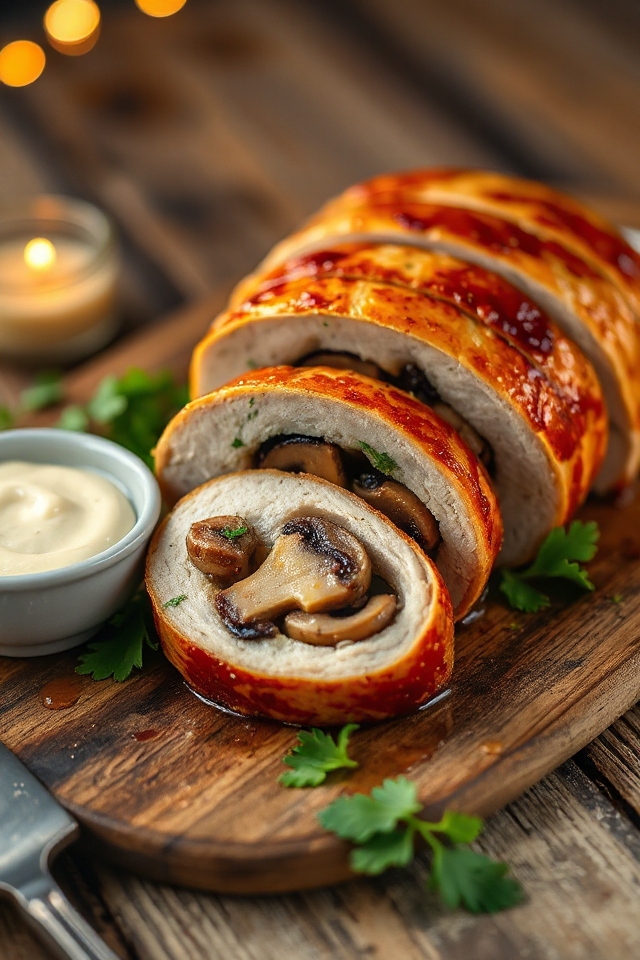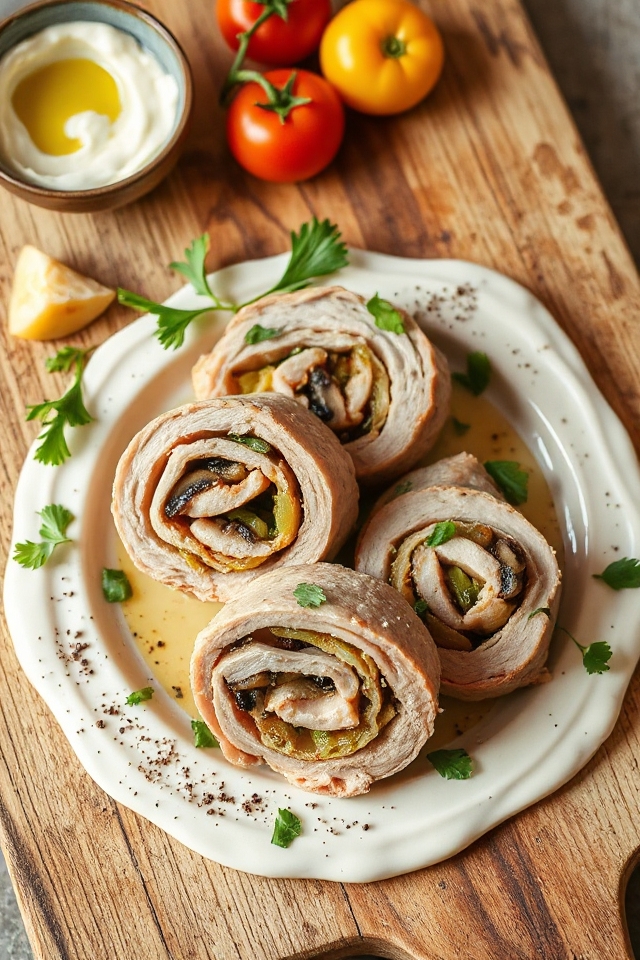Why You’ll Love this Stuffed Pork Tenderloin Recipe
Stuffed pork tenderloin is a show-stopper that’s perfect for any occasion. I can’t tell you how many times I’ve impressed guests with this dish.
The combination of tender, juicy pork and flavorful stuffing makes every bite memorable. Plus, it’s surprisingly easy to prepare, so I never feel overwhelmed.
The vibrant colors of the filling make for a beautiful presentation, and the aroma wafting through my kitchen is simply irresistible.
It’s versatile, too; I can serve it for a casual family dinner or dress it up for a special celebration.
Trust me, this recipe is bound to become a favorite in your home!
Ingredients of Stuffed Pork Tenderloin
When it comes to making a delicious stuffed pork tenderloin, gathering the right ingredients is essential. Trust me, these ingredients come together to create a dish that isn’t only mouthwatering but also gives you that warm, fuzzy feeling when you serve it to family and friends.
So, let’s get into the nitty-gritty of what you’ll need to whip up this culinary masterpiece.
- 3 tablespoons extra virgin olive oil
- 3 cups thinly sliced leeks (white and light green parts only)
- 3 cups chopped mushrooms
- 1/2 teaspoon crumbled dried thyme
- 1/2 teaspoon salt
- 1/4 teaspoon black pepper
- 1/2 cup fresh breadcrumbs
- 1/2 cup freshly grated Parmigiano-Reggiano cheese
- 1/4 cup chopped fresh parsley
- 24 ounces pork tenderloin (12 ounces each)
- 1 tablespoon Dijon mustard
- 1/4 teaspoon salt (for seasoning the pork)
- 1/4 teaspoon black pepper (for seasoning the pork)
- 1 cup roasted garlic mayonnaise (like Hellmann’s)
Now, when you’re gathering your ingredients, you might be tempted to grab any old mushroom or cheese, but trust me, you’ll want the good stuff. Fresh leeks and mushrooms can make a world of difference in flavor, and don’t skimp on that Parmigiano-Reggiano cheese—it’s what gives the stuffing that rich, nutty flavor.
And if you’re feeling adventurous, consider adding a bit of fresh garlic to the mix or swapping out the mayo for a homemade version, if you’re really in the mood to impress.
How to Make Stuffed Pork Tenderloin

Making a stuffed pork tenderloin might sound a bit intimidating, but trust me, it’s not as challenging as it seems. Let’s dive right in. First off, grab your 3 tablespoons of extra virgin olive oil and warm it up in a large frying pan over medium-high heat. Once that oil is shimmering, toss in 3 cups of thinly sliced leeks and 3 cups of chopped mushrooms. Sauté these for about 3 minutes until the leeks become tender and the mushrooms release their juices. Oh, the aroma will start to fill your kitchen, and you might just find yourself daydreaming about the deliciousness to come.
Now, sprinkle in 1/2 teaspoon of crumbled dried thyme, 1/2 teaspoon of salt, and 1/4 teaspoon of black pepper. Give it another minute or two on the heat, and then let it cool slightly.
Here comes the fun part. After the sautéed mixture has cooled a bit, toss it into a food processor. Add in 1/2 cup of fresh breadcrumbs, 1/2 cup of freshly grated Parmigiano-Reggiano cheese, and 1/4 cup of chopped fresh parsley. Pulse it just enough to blend everything together into a sticky stuffing that’s just begging to be wrapped in meat.
Now, preheat your oven to 350°F; you’ll want it nice and toasty for later.
Next, grab your 24 ounces of pork tenderloin (that’s two pieces, each 12 ounces). Carefully cut each tenderloin lengthwise, about 3/4 of the way through, and then open it up like a book. Using a food mallet (or maybe even a rolling pin if you’re feeling rebellious), flatten the tenderloin to about 1/2 inch thick. Spread half of that glorious stuffing mixture you just made over each piece of meat, pressing it down firmly so it sticks.
Now, roll each tenderloin up from one of the shorter ends, tucking in that delicious stuffing as you go. Tie them up with kitchen string in at least three places, just to make sure everything stays put. Brush each roll with 1 tablespoon of Dijon mustard and sprinkle a little salt and pepper on top.
Place these beauties side by side in a small roasting pan and pop them into the oven for 35 to 45 minutes. You’ll know they’re done when the internal temperature hits 155°F. After they come out of the oven, let them rest for about 10 minutes. Slice them into spirals about 3/4 inch thick, and serve them warm or at room temperature with a generous dollop of roasted garlic mayonnaise.
It’s going to be a hit, I promise. Just don’t forget to save some for yourself—you know, after you plate it up for your guests!
Stuffed Pork Tenderloin Substitutions & Variations
After mastering the art of rolling up that delectable pork tenderloin, you might want to explore some fun substitutions and variations to personalize the dish.
For a twist, try using spinach and feta cheese in your stuffing instead of leeks and mushrooms. If you’re feeling adventurous, add some dried cranberries or chopped nuts for texture and flavor.
Want a spicy kick? Incorporate jalapeños or chorizo. You can even switch the pork for chicken or turkey tenderloins.
The possibilities are endless! Don’t hesitate to experiment; finding your favorite combination is part of the fun in cooking. Enjoy the journey!
What to Serve with Stuffed Pork Tenderloin
What should you serve alongside your stuffed pork tenderloin to create a well-rounded meal?
I love pairing it with creamy mashed potatoes or crispy roasted potatoes for a comforting side.
A revitalizing green salad with a tangy vinaigrette complements the richness of the pork beautifully.
For a touch of sweetness, try sautéed green beans with caramelized shallots or honey-glazed carrots.
If you’re in the mood for something heartier, consider a wild rice pilaf.
Don’t forget a drizzle of the roasted garlic mayonnaise on the side—it elevates the entire dish!
Enjoy your meal with a nice glass of white wine.
Additional Tips & Notes
When planning your meal, consider a few extra tips to enhance your stuffed pork tenderloin experience.
First, don’t rush the cooling step after sautéing the leeks and mushrooms; letting them cool helps maintain the stuffing’s texture.
Also, feel free to experiment with different herbs or add nuts for extra crunch.
When rolling the tenderloin, make certain it’s tight to keep the stuffing intact.
Using a meat thermometer is key to preventing overcooking.
Finally, let the meat rest after roasting; it helps retain juices for a more flavorful bite.
Enjoy the process, and your guests will surely love the results!
